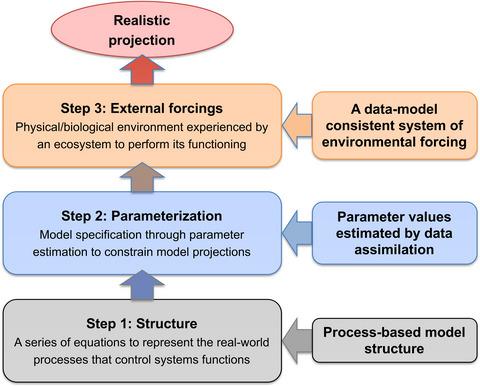当前位置:
X-MOL 学术
›
Glob. Change Biol.
›
论文详情
Our official English website, www.x-mol.net, welcomes your feedback! (Note: you will need to create a separate account there.)
Model parameterization to represent processes at unresolved scales and changing properties of evolving systems.
Global Change Biology ( IF 11.6 ) Pub Date : 2019-11-28 , DOI: 10.1111/gcb.14939 Yiqi Luo 1 , Edward A G Schuur 1
Global Change Biology ( IF 11.6 ) Pub Date : 2019-11-28 , DOI: 10.1111/gcb.14939 Yiqi Luo 1 , Edward A G Schuur 1
Affiliation

|
Modeling has become an indispensable tool for scientific research. However, models generate great uncertainty when they are used to predict or forecast ecosystem responses to global change. This uncertainty is partly due to parameterization, which is an essential procedure for model specification via defining parameter values for a model. The classic doctrine of parameterization is that a parameter is constant. However, it is commonly known from modeling practice that a model that is well calibrated for its parameters at one site may not simulate well at another site unless its parameters are tuned again. This common practice implies that parameter values have to vary with sites. Indeed, parameter values that are estimated using a statistically rigorous approach, that is, data assimilation, vary with time, space, and treatments in global change experiments. This paper illustrates that varying parameters is to account for both processes at unresolved scales and changing properties of evolving systems. A model, no matter how complex it is, could not represent all the processes of one system at resolved scales. Interactions of processes at unresolved scales with those at resolved scales should be reflected in model parameters. Meanwhile, it is pervasively observed that properties of ecosystems change over time, space, and environmental conditions. Parameters, which represent properties of a system under study, should change as well. Tuning has been practiced for many decades to change parameter values. Yet this activity, unfortunately, did not contribute to our knowledge on model parameterization at all. Data assimilation makes it possible to rigorously estimate parameter values and, consequently, offers an approach to understand which, how, how much, and why parameters vary. To fully understand those issues, extensive research is required. Nonetheless, it is clear that changes in parameter values lead to different model predictions even if the model structure is the same.
中文翻译:

对模型参数化进行建模,以代表未解决规模的过程和不断变化的系统特性。
建模已成为科学研究必不可少的工具。但是,当模型用于预测或预测生态系统对全球变化的响应时,它们会产生很大的不确定性。这种不确定性部分归因于参数化,这是通过定义模型的参数值进行模型规范的基本过程。参数化的经典学说是参数是常数。但是,从建模实践中通常可以知道,在一个位置对其参数进行了很好校准的模型,除非再次调整其参数,否则在另一个位置可能无法很好地模拟。这种常见做法意味着参数值必须随站点而变化。实际上,使用统计上严格的方法(即数据同化)估算的参数值会随时间,空间,和全球变化实验中的处理方法。本文说明,变化的参数要考虑到两个问题:未解决的规模和不断变化的系统特性。一个模型,无论多么复杂,都不能代表一个系统在已解决的规模上的所有过程。模型参数中应反映出未解决规模的流程与已解决规模的流程之间的相互作用。同时,普遍观察到生态系统的特性会随着时间,空间和环境条件的变化而变化。代表所研究系统的属性的参数也应更改。调节已进行了数十年,以更改参数值。但是,不幸的是,该活动根本没有帮助我们了解模型参数化。数据同化使得可以精确估计参数值,从而提供一种了解哪些,如何,多少以及为什么参数变化的方法。为了完全理解这些问题,需要进行广泛的研究。尽管如此,很明显,即使模型结构相同,参数值的变化也会导致不同的模型预测。
更新日期:2020-01-13
中文翻译:

对模型参数化进行建模,以代表未解决规模的过程和不断变化的系统特性。
建模已成为科学研究必不可少的工具。但是,当模型用于预测或预测生态系统对全球变化的响应时,它们会产生很大的不确定性。这种不确定性部分归因于参数化,这是通过定义模型的参数值进行模型规范的基本过程。参数化的经典学说是参数是常数。但是,从建模实践中通常可以知道,在一个位置对其参数进行了很好校准的模型,除非再次调整其参数,否则在另一个位置可能无法很好地模拟。这种常见做法意味着参数值必须随站点而变化。实际上,使用统计上严格的方法(即数据同化)估算的参数值会随时间,空间,和全球变化实验中的处理方法。本文说明,变化的参数要考虑到两个问题:未解决的规模和不断变化的系统特性。一个模型,无论多么复杂,都不能代表一个系统在已解决的规模上的所有过程。模型参数中应反映出未解决规模的流程与已解决规模的流程之间的相互作用。同时,普遍观察到生态系统的特性会随着时间,空间和环境条件的变化而变化。代表所研究系统的属性的参数也应更改。调节已进行了数十年,以更改参数值。但是,不幸的是,该活动根本没有帮助我们了解模型参数化。数据同化使得可以精确估计参数值,从而提供一种了解哪些,如何,多少以及为什么参数变化的方法。为了完全理解这些问题,需要进行广泛的研究。尽管如此,很明显,即使模型结构相同,参数值的变化也会导致不同的模型预测。



























 京公网安备 11010802027423号
京公网安备 11010802027423号